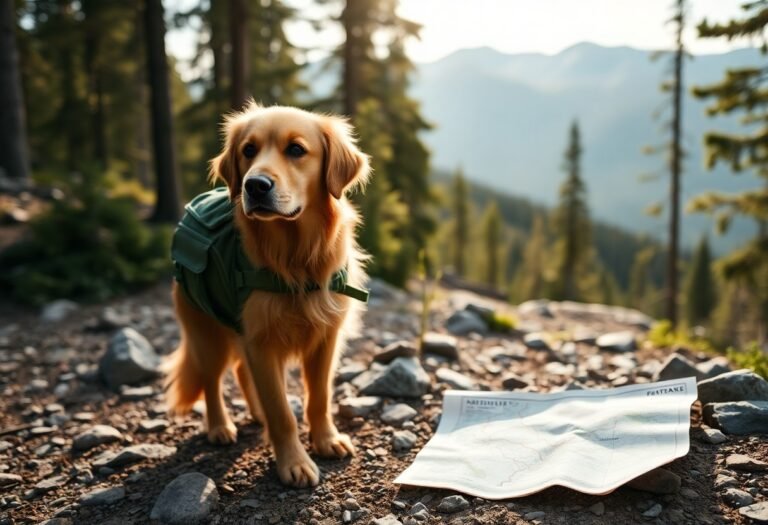Over the summer months, the allure of outdoor adventures beckons, especially for avid dog owners like you who love exploring nature. Ensuring a safe hiking experience for both you and your furry companion involves careful planning and awareness of the environment. From understanding trail etiquette to staying hydrated, this post will guide you through crucial tips to make your summer trail adventures enjoyable and safe for both you and your dog.
Essential Preparations for Your Trail Outing
Planning a trail outing with your dog requires a bit of forethought to ensure a seamless experience. Start by mapping out your route, taking note of trail regulations that pertain to pets, and researching the terrain and weather conditions for that day. These considerations help tailor your adventure to suit your dog’s abilities. Bring plenty of water, snacks, and a first-aid kit specifically for pets, so you’re prepared for any bumps along the way. With the right preparation, your trail outing will be both enjoyable and safe!
Gear Up: Must-Have Equipment for Dogs
Equipping your dog for the adventure is key to keeping them safe and comfortable. Opt for a well-fitted harness instead of a standard collar, as it provides better control and minimizes strain on your dog’s neck. Consider a lightweight backpack designed for dogs, allowing them to carry their supplies while contributing to the journey. Additionally, dog booties can protect their paws from rough terrain, and a reflective vest ensures visibility during low-light conditions. With the right gear, your dog can fully enjoy the exploration while staying safe.
Health Check: Vet Visits and Vaccinations
Scheduling a vet visit ahead of your trail outing ensures that your dog is ready for the adventure. Ensure their vaccinations are up to date, particularly rabies and kennel cough, which can be imperative for public trail litter. Discuss your plans with your veterinarian to confirm your dog’s fitness for outdoor activities. Not only does this safeguard against the transmission of diseases, but it also provides you peace of mind knowing that any potential health issues are addressed before venturing out.
A routine health check is an excellent opportunity to evaluate your dog’s overall condition. Annual vaccinations are vital, especially when exposing them to other animals on the trails. A vet can also identify any potential health concerns, such as joint issues or allergies, that may arise during outdoor activities. Moreover, consider asking about preventative medications for ticks and fleas, especially in regions known for infestations; this can protect your dog from parasites that thrive in nature. By being proactive about your dog’s health, you prepare for a happier, more enjoyable summer adventure.
Trail Etiquette and Safety Protocols
Understanding proper trail etiquette and safety protocols ensures a harmonious experience for both you and your dog. Being respectful to fellow hikers and the environment is imperative, particularly in leash enforcement, waste disposal, and maintaining noise levels. Familiarize yourself with the trail rules, as certain areas may have specific regulations regarding dog access. Following these guidelines not only safeguards your adventure but also cultivates a positive atmosphere for everyone involved.
Keeping Your Dog Leashed: The Why and How
Leashing your dog on the trails serves multiple purposes, primarily safety. It prevents your dog from running off and potentially getting lost, encountering wildlife, or causing disturbances with other hikers. Opt for a sturdy, adjustable leash that allows some freedom while still maintaining control. Train your dog to enjoy being leashed by using positive reinforcement techniques, like treats and praise, so they associate it with a pleasant experience.
Interacting with Other Hikers and Dogs Safely
Safe interactions with other hikers and dogs begin with clear communication and consideration. Always ask permission before approaching others and their pets, as not every dog is friendly or accustomed to socializing. Maintain a polite distance, especially if you notice a dog is timid, aggressive, or on high alert. If your dog is friendly and excited, keep them close to avoid overwhelming others. Observing others’ body language can provide clues about their comfort levels, allowing you to adjust your approach accordingly.
Creating a positive interaction environment is key to enjoying the trails. If you encounter another dog, watch for signs of acceptance, such as wagging tails and relaxed postures. When in doubt, it’s best to introduce your dogs gradually or to keep them at a distance until you assess their temperament. Should you find yourself in a crowded area, consider stepping off the path to allow space for others. These practices not only enhance your hiking trips but also foster goodwill and community spirit among fellow trail enthusiasts.
Navigating Environmental Challenges
Outdoor adventures with your dog often bring unique environmental challenges that require careful navigation. Whether it’s uneven terrain, drastic weather changes, or the presence of wildlife, awareness and preparation play significant roles in ensuring a safe and enjoyable experience on the trails. Adapting to these challenges can make the difference between a delightful hike and an unexpected mishap.
Understanding Weather Impact on Trail Conditions
Weather can significantly alter trail conditions, so keeping an eye on the forecast before heading out is vital. Rain can turn trails into muddy soup, while summer heat can lead to dehydration concerns for your furry companion. Snow, too, can hide rocks and branches. By checking trail conditions and adjusting your route or timing accordingly, you’ll keep both you and your dog safe from potentially hazardous situations.
Recognizing and Avoiding Hazards: Wildlife and Plants
Being aware of the wildlife and plant life in your hiking area is key to avoiding hazards. Certain regions may have snakes, ticks, or plants like poison ivy that pose risks to both you and your dog. Knowing how to identify these dangers means you can make informed choices about your route and what to look out for during your excursion.
For instance, in certain areas, you might encounter rattlesnakes, especially during warmer months. Teach your dog commands that alert them to stay away from wild animals, and carry a first-aid kit just in case. Similarly, some common plants are harmful—like foxglove and oleander—so educating yourself on local flora can prevent poisoning. Taking time to learn about your hiking environment can enrich your adventure and minimize risks, keeping your dog safe and healthy while enjoying nature together.
Hydration and Nutrition on the Go
Maintaining your dog’s hydration and nutrition during trail excursions is imperative for a fun and safe adventure. Always bring fresh water in a portable bowl to keep your pup hydrated, especially on warm days. Pack a variety of energy-boosting snacks that your dog enjoys to keep their spirits high. Frequent breaks for water and treats ensure that your dog remains healthy and energized to enjoy the journey ahead.
Importance of Water for Active Dogs
Active dogs need a steady supply of water, particularly when they are exerting themselves on trails. Dehydration can lead to fatigue, overheating, and serious health issues. Carrying an appropriate amount of water—approximately 1 ounce per pound of body weight per day—is advisable to keep your furry companion well-hydrated.
Selecting Energy-Boosting Snacks for the Trail
Choosing the right snacks for your outdoor adventure can significantly enhance your dog’s energy levels and overall enjoyment. Opt for high-protein treats, such as chicken jerky or beef liver, which provide sustained energy. Additionally, consider wholesome snacks like peanut butter-stuffed Kongs or dehydrated fruits that enrich their diet and keep them excited about meal times on the trail.
When dicking out energy-boosting snacks, keep your dog’s nutritional needs in mind. High-quality ingredients are imperative, so look for treats with minimal fillers and artificial additives. Consider your dog’s size and activity level when portioning snacks—smaller pieces may be better for frequent munching on the go, while larger treats can serve as substantial rewards during rest breaks. Always try out new snacks at home to ensure your dog enjoys them before relying on them during your adventure.
Post-Adventure Care and Reflection
Your time on the trails doesn’t end when you head back home. Conducting a thorough post-adventure check is key to ensuring your dog’s health and well-being. This involves observing their behavior, monitoring any signs of fatigue, and assessing their overall condition. Taking a moment to reflect on the adventure also helps you identify what went well and what can be improved for future outings. This proactive approach not only maintains your dog’s health but enhances your overall hiking experience.
Signs of Fatigue: Recognizing When to Stop
Knowing when your dog is tired is crucial for a safe adventure. Look for signs like lagging behind, heavy panting, or a decrease in enthusiasm. If your dog suddenly stops to lay down or seems reluctant to continue, it’s time to take a break or head home. Each dog has a different endurance level; trust your instincts and don’t push them beyond their limits.
Assessing Your Dog’s Health After the Hike
After a hike, closely examine your dog for any physical signs that could indicate issues. Check their paws for cuts, signs of overheating, and overall hydration levels. Look for any unusual limping or reluctance to move that might suggest soreness or injuries. Keep an eye on their behavior; a sudden change in mood or energy could indicate a problem that needs attention.
Performing a more detailed examination of your dog can prevent many common hiking-related complications. Start by checking their paws for abrasions, ticks, or embedded debris, which can lead to infections. Observe their breathing rate and ensure they’re not excessively panting or lethargic, as these can be warning signs of overheating. Additionally, assess their hydration by gently pinching the skin—if it doesn’t quickly return to its original position, your dog may be dehydrated. Taking these steps ensures your furry friend remains healthy and happy, ready for your next adventure together.
Conclusion
Hence, you can ensure a safe summer adventure with your dog on the trails by thoroughly planning your outings, providing adequate hydration, protecting against pests, and staying aware of your dog’s health and behavior. Equip yourself with imperative supplies like a first aid kit and a leash, and always follow local regulations to keep both you and your furry friend secure. By taking these steps, you can enjoy a memorable summer filled with exploration and fun while prioritizing your dog’s well-being.




